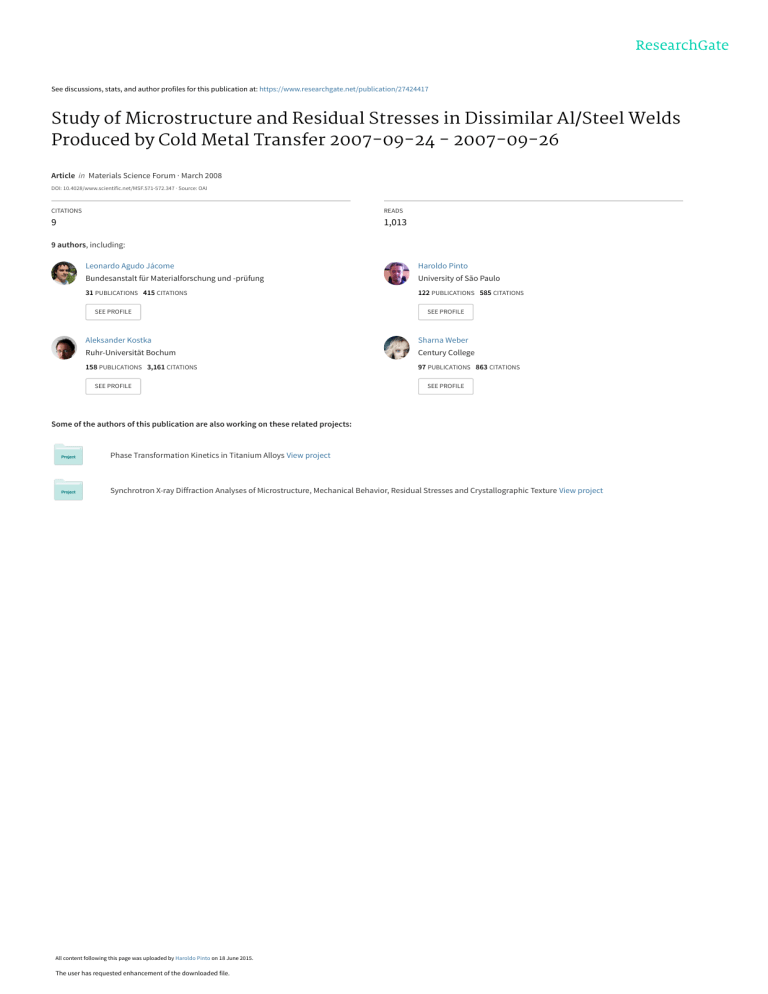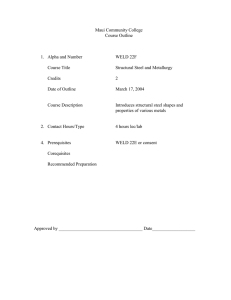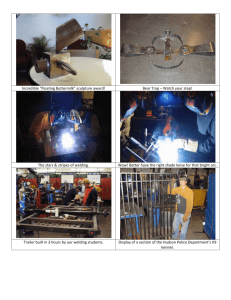
See discussions, stats, and author profiles for this publication at: https://www.researchgate.net/publication/27424417
Study of Microstructure and Residual Stresses in Dissimilar Al/Steel Welds
Produced by Cold Metal Transfer 2007-09-24 - 2007-09-26
Article in Materials Science Forum · March 2008
DOI: 10.4028/www.scientific.net/MSF.571-572.347 · Source: OAI
CITATIONS
READS
9
1,013
9 authors, including:
Leonardo Agudo Jácome
Haroldo Pinto
Bundesanstalt für Materialforschung und -prüfung
University of São Paulo
31 PUBLICATIONS 415 CITATIONS
122 PUBLICATIONS 585 CITATIONS
SEE PROFILE
SEE PROFILE
Aleksander Kostka
Sharna Weber
Ruhr-Universität Bochum
Century College
158 PUBLICATIONS 3,161 CITATIONS
97 PUBLICATIONS 863 CITATIONS
SEE PROFILE
SEE PROFILE
Some of the authors of this publication are also working on these related projects:
Phase Transformation Kinetics in Titanium Alloys View project
Synchrotron X-ray Diffraction Analyses of Microstructure, Mechanical Behavior, Residual Stresses and Crystallographic Texture View project
All content following this page was uploaded by Haroldo Pinto on 18 June 2015.
The user has requested enhancement of the downloaded file.
Materials Science Forum Vols. 571-572 (2008) pp 347-353
online at http://www.scientific.net
© (2008) Trans Tech Publications, Switzerland
Online available since 2008/Mar/07
Study of Microstructure and Residual Stresses in dissimilar Al/Steels
welds produced by Cold Metal Transfer
L. Agudo1,a, S. Weber1,b, H. Pinto 1,c, E. Arenholz2,d, J. Wagner2,e, H. Hackl3,f,
J. Bruckner3,g, A. Pyzalla1,h
1
Max-Planck Institut für Eisenforschung GmbH, Max-Planck Str. 1, 40237 Düsseldorf, Germany2
voestalpine Stahl GmbH, voestalpine – Strasse 3, 4020 Linz, Austria
3
Fronius GmbH, Buxbaumstraße 2, 4600 Wels, Austria
agudo@mpie.de, bweber@mpie.de, cpinto@mpie.de, dEnno.Arenholz@voestalpine.com,
e
Juergen.Wagner@voestalpine.com, fHackl.Heinz@fronius.com, gBruckner.Juergen@fronius.com,
h
pyzalla@mpie.de
a
Keywords: CMT, Welding, Aluminum, Residual Stresses, Microstructure
Abstract. Recently a new welding technique, the so-called ‘Cold Metal Transfer’ (CMT) technique
was introduced, which due to integrated wire feeding leads to lower heat input and higher
productivity compared to other gas metal arc (GMA) techniques. Here microstructure formation and
residual stress state in dissimilar steel to aluminum CMT welds are investigated. The intermetallic
phase seam between the filler and the steel is only a few micrometers thick. Residual stress analyses
reveal the formation of the typical residual stress state of a weld without phase transformation. Both
in longitudinal and in transversal direction compressive residual stresses exist in the steel plate
parent material, tensile residual stresses are present in the heat affected zone of the steel and the
aluminum alloy. The area containing tensile residual stresses is larger in the aluminum alloy due to
its higher heat conductivity than in the steel. Due to the symmetry in the patented voestalpine
welding geometry and the welding from bottom and face side of the weld, the residual stress
distributions at the top and at the bottom side of the weld are very similar.
Introduction
Tailored blanks combining steel and aluminum alloys could be very advantageous for light-weight
engineering in automotive industry [1-3]. The production of these tailored blanks necessitates the
development of reliable and cost efficient joining methods, which yield joints with good mechanical
properties and in particular good forming characteristics as well as sufficient corrosion resistance.
Fusion welding of steels to aluminum alloys, however, still remains a challenge because of the
large differences in their electrochemical potential, their melting point, their thermal expansion
coefficient and their thermal conductivity, and in particular due to the formation of brittle
intermetallic aluminum-rich FexAly intermetallic phases [4] (Fig. 1) in the weld seam.
Among the fusion joining techniques for joining steel to aluminum sheets is laser beam joining
by heat conduction through the steel into the aluminum alloy which then melts and bonds to the
steel surface. Main drawbacks of the laser welding process are the necessity of a flux medium, the
limitation of the steel sheet thickness to about 1.5mm to ensure heat transfer, high requirements on
the flatness and restrictions in allowable variation in size of the sheets to be joined and the high
investment costs [5-7].
All rights reserved. No part of contents of this paper may be reproduced or transmitted in any form or by any means without the written permission of the
publisher: Trans Tech Publications Ltd, Switzerland, www.ttp.net. (ID: 192.12.81.1-07/03/08,14:05:04)
348
Stress Evaluation Using Neutrons and Synchrotron Radiation
Fig. 1. Fe-Al Phase Diagram [4]
Another fusion joining technique for steel to aluminum welds is the so-called ‘Cold Metal
Transfer’ (CMT) technique, which was introduced by Fronius International GmbH, Wels, Austria.
From the point of view of welding, ‘cold’ is a relative concept. In the CMT technique the work
pieces to be joined, remain considerably ‘colder’ than in conventional ‘Gas Metal Arc’ (GMA)
processes. The main characteristic that distinguishes the CMT welding process from a conventional
metal arc welding technique is the incorporation of wire motion into process control (Fig. 2a),
which substantially reduces heat input [8]. In addition the patented voestalpine welding geometry
[9,10] is symmetric (Fig. 2b), which improves mechanical properties as well as corrosion protection.
Due to the large difference in the melting points in case of fusion joining steel to aluminum
alloys, the aluminum alloy usually melts while the steel remains in solid state. Therefore, joining of
Al-alloys to steel is usually achieved via aluminum alloy filler. The aluminum alloy is welded to the
aluminum alloy filler material while brazing occurs between the filler and the steel. The filler
material is chosen under the pre-conditions that it has sufficient strength and ductility, and that the
formation of intermetallic phases can be controlled with respect to both structure of the intermetallic
phases and thickness of the intermetallic phase seam. Based on earlier work [11-13] AlSi3Mn1 was
chosen as filler here and Al99.5 serves as a reference filler material.
Experimental Details
Welding. Using the CMT method, 1mm thick DX54D+Z200 steel sheets were joined to 1.5mm
thick AW5182-H111 sheets at Fronius International GmbH using 1.2mm diameter Al99.5 and
AlSi3Mn1 filler wires, all parent materials being provided by voestalpine Stahl GmbH.
The optimized voestalpine welding geometry [9-11] (Fig. 2) and optimized parameters for the
CMT welding process were chosen (Table 1). The samples were clamped during the welding
process in order to avoid distortion.
Metallography and Microscopy. For optical (OM), scanning electron (SEM) and transmission
electron (TEM) microscopy, specimens were cut, ground and polished. Specimen microstructure
was characterized in the SEM using electron back scattering diffraction (EBSD).
Materials Science Forum Vols. 571-572
349
Fig. 2. (a) Sequence of CMT process stages and b) Geometry of the steel-aluminum CMT-weld (detail from
(a), right)
Table 1. Welding parameters
Weld
CMT
vS
[cm/min]
vD [m/min]
I [A]
U [V]
f [Hz]
4.5
70
12
70
60
vS: Welding speed, vD: Wire feeding speed, I: Current, U: Voltage, f: Frequency.
Table 2. Properties of the aluminum alloy, steel parent material and the AlSi3Mn1 filler [11]
(α
α: coefficient of thermal expansion, κ: thermal conductivity).
Rp0.2 [MPa]
Rm [MPa]
α [1/K]
κ [W/mK]
DX54D+Z
182±1
313±2
~12x10-6*
~75*
AW5182-H111
142±2
276±1
AlSi3Mn1
50
120
~24x10-6**
~240**
*for pure Iron; ** for pure Aluminum
Residual Stress Analysis. Residual stress analysis was carried out using the instrument G3 at
HASYLAB, DESY, Hamburg, Germany at 6.4keV energy. Residual stresses in longitudinal (along
the weld) and in transversal direction were determined by the sin2ψ method (Al311 and α-Fe200
reflections) at the top and bottom of a AW5182-H111 aluminum to DX54D+Z200 steel butt-joint
with AlSi3Mn1 filler, in the center of the weld seam and along both the steel and aluminum sheets
up to 80mm distance from the weld centerline (Fig. 3). Face and bottom sides of the butt joint were
electro-polished in order to access residual stresses in a depth of 100µm beneath the original
surface. After electro-polishing residual stresses were determined in the weld seam, and in the
aluminum and steel sheets up to a distance of 35mm from the weld seam. The diffraction elastic
constants were calculated using Kröner’s model [14].
350
Stress Evaluation Using Neutrons and Synchrotron Radiation
Fig. 3. Scheme of stress measurement locations. Iconography corresponds to Fig. 5 and Fig. 6.
Results and Discussion
Microstructure. The welds did not contain any welding defects. Few pores (Fig. 2b) are visible,
which are commonly formed in fusion-welded aluminum alloys due to their small solidification
interval, which hampers the release of dissolved gas.
Micrographs of the welded samples reveal different intermetallic phase morphologies (Fig. 4) at
the interface between the molten filler and the steel when using Al99.5 and AlSi3Mn1 filler
materials. The chosen welding parameters ensured that the thickness of the intermetallic phase seam
(IMP) in both welds with Al99.5 filler (IMP thickness about 3.5µm) and AlSi3Mn1 filler (IMP
thickness about 2.5µm) was well below the 10µm limit, which often has been claimed to be critical
with respect to weld toughness [15,16]. The phases identified in the IMP of the weld with the
Al99.5 filler are θ-phase Al3Fe (adjacent the filler) and η-phase Al5Fe2 (adjacent to the steel). The
intermetallic phase seam in case of the AlSi3Mn1 filler contains also the θ-phase Al3Fe and the ηphase Al5Fe2 and additionally an Al(Fe,Mn)Si – phase.
Fig. 4. SE-SEM micrograph showing the intermetallic phase seam (IMP) in welds with (a) Al99.5 filler and
(b) AlSi3Mn1 filler.
Residual Stresses. Because of its higher technical relevance due to the higher strength of the
AlSi3Mn1 filler compared to the Al99.5 filler residual stress analyses focused on the weld with the
AlSi3Mn1 filler material.
The residual stress distributions at the surface of the face side of the weld and 100µm beneath the
surface of the weld face side are very similar (Fig. 5a), the same is true for the residual stresses at
the surface of the bottom side of the welds (Fig. 5b, Fig. 6) and 100µm beneath it.
The residual stress distribution in longitudinal direction both at the face (Fig. 5a) and the bottom
side of the weld (Fig. 5b) are characterized by compressive residual stresses within the steel plate
parent material, which turn into tensile residual stresses in the heat affected zone with a steep
gradient. The filler in the weld seam and the heat affected zone in the aluminum alloy are under
tensile residual stresses, and the aluminum parent material contains balancing compressive residual
Materials Science Forum Vols. 571-572
351
stresses in longitudinal direction. The maximum value of the residual stresses in the aluminum
alloy, on the top side of the weld near the weld seam, is as high as 100 MPa and, thus, about 2/3 of
its yield strength.
The residual stress distribution in transversal direction at the bottom side of the weld (Fig. 6) is
very similar to the residual stress distribution in longitudinal direction. The residual stress values
encountered are slightly lower in transversal direction compared to the longitudinal direction.
The residual stress distributions determined are typical for welds without phase transformation.
Martensitic phase transformation (proven by temperature measurements and also by metallography)
does not occur in the steel because the temperature reached in the joining process basically is only
slightly higher than the melting temperature of the aluminum alloy.
Fig. 5. Residual stress state along the longitudinal direction (↓) of a joint with AlSi3Mn1 aluminum
filler on the surface and ~100µm beneath on (a) top and (b) bottom side.
Fig. 6. Residual stress state along the transversal direction (→) of a joint with AlSi3Mn1 aluminum filler on
surface and ~100µm beneath on bottom side.
The cold parent materials hinder shrinkage of the weld seam and the heat affected zone, thus
introducing compressive residual stresses into the base material and tensile residual stresses into the
weld seam and the heat affected zone [16].
352
Stress Evaluation Using Neutrons and Synchrotron Radiation
The thermal conductivity of the aluminum alloy is larger than the thermal conductivity of the
steel (Table 2). Therefore, the heat affected zone and the region containing tensile residual stresses
is larger in the aluminum alloy than in the steel. The larger extension of the stress field conductivity
and the higher thermal expansion coefficient of the aluminum alloy (Table 2) contribute to its
slightly higher tensile residual stresses compared to the steel plate and to the compressive residual
stresses in the steel plate parent material.
The strong similarity between the residual stress at the face and the bottom side of the weld can
be attributed both to the welding process, which includes welding at both the top and the bottom
side of the weld and to the symmetry of the voestalpine welding geometry.
Summary and Conclusions
The microstructure formation and the residual stress state in joints of dissimilar steel to aluminum
alloys were investigated. The welds were manufactured by the CMT method (a modified gas metal
arc welding technique) in the voestalpine welding geometry using an AlSi3Mn1 filler material.
Microstructure analyses show welding between aluminum alloy and filler and brazing between
filler and steel. The intermetallic phase seam at the interface between filler and steel is only few
micrometers thick.
Residual stress analyses reveal a typical welding residual stress state of a weld without phase
transformation. Both in longitudinal and in transversal direction compressive residual stresses are
present in the steel plate parent material, while tensile residual stresses were determined in the heat
affected zone of the steel and the aluminum alloy. The area containing tensile residual stresses due
to its higher heat conductivity is larger in the aluminum alloy than in the steel. The residual stress
distributions at the top and at the bottom side of the weld are very similar due to controlled welding
parameters and the symmetric welding geometry.
Acknowledgements
The authors thank Dr. A. Rothkirch and Dr. T. Wroblewski, HASYLAB at DESY and in particular
Dipl.-Ing. (FH) Benjamin Breitbach, MPIE, for experimental support.
References
[1] G. Kobe, Aluminium/steel welding, Automotive Industries 7 (1994) 44.
[2] S. Ramasamy, Welding Journal 2 (2003) 35 -39.
[3] J. Bruckner, E. Arenholz, G. Schmid, Gas-Metal-Arc-joining of steel to aluminium, 5. CTI
Fachkonferenz “Modularisierung & Leichtbau im Kfz-Karosseriebau“, Stuttgard (2007)
[4] O. Kubaschewski in Iron–Binary Phase Diagrams, Springer-Verlag, Berlin, (1982) 5.
[5] Radscheit, C. R., Laserstrahlfügen von Aluminium mit Stahl, Dissertation, Strahltechnik Bd. 4
Bremen, G. Sepold and W. Jüptner , ed., BIAS Verlag (1997).
[6] M. Kreimeyer; Laserstrahlfügen von Aluminium mit Stahl unter Verwendung eines
optimierten Arbeitskopfes, Diploma thesis, FHO-Emden and BIAS, Bremen (1999).
[7] I. Zerner, E. Schubert, G. Sepold, Laserstrahlfügen von Aluminium mit Stahl, BIAS (1998).
[8] J. Bruckner, J. Wagner, E. Arenholz, The CMT-Process- A revolution in welding technology,
Proc. 2nd International Light Weight Metals Technology Conference 2005, H. Kaufmann, ed.
Austria (2005) 275.
[9] C. Schmaranzer, K.H. Stellnberger, A. Leitner, Verfahren zum Fügen zweier Bleche einerseits
aus einem Aluminiumwerkstoff und andererseits aus einem Eisen- oder Titanwerkstoff,
Europäische Patentanmeldung, EP 1 585 612 B1
[10] C. Schmaranzer, A. Leitner, Träger für eine Fahrzeugkarosserie, Österreichische
Patentanmeldung Nr. A 972/2003, AT 412.550 B, EP 1 636 083 B1.
[11] C. H. Schmaranzer, Herstellung, Mikrostruktur und Eigenschaften von Stahl-Aluminium
Hybridplatinen, Dissertation, TU Wien, Austria (2004).
Materials Science Forum Vols. 571-572
353
[12] L. Agudo, D. Eyidi, C.H. Schmaranzer, E. Arenholz, N. Jank, J. Bruckner and A.R. Pyzalla, J.
Mat. Sci. 42-12 (2007) 4205.
[13] L. Agudo, N. Jank, S. Weber, E. Arenholz, J. Bruckner and A.R. Pyzalla, J. Steel Res. Int.,
Submitted.
[14] V. Hauk, Structural and Residual Stress Analysis by Nondestructive Methods, Elsevier,
Amsterdam (1997).
[15] D. R. G. Achar, J. Ruge, S. Sundaresan, Joining aluminium to steel, with particular reference
to welding, Aluminium-Monography; Aluminium Verlag, Bonn (1980).
[16] Lison R., Schweißen und Schneiden, 28-3 (1976) 89.
View publication stats


